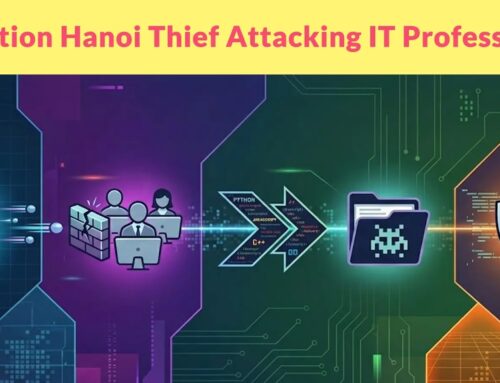
New Phishing Kit Automates Generation of ClickFix Attack Bypassing Security Measures
The ClickFix Threat: A New Era of Automated Phishing Attacks
The cybersecurity landscape faces a growing challenge as threat actors continually refine their tactics. A recent development amplifying this threat is the emergence of a novel phishing toolkit that automates the generation of “ClickFix” attack pages. This kit significantly lowers the bar for cybercriminals, enabling even those with minimal technical expertise to deploy sophisticated social engineering lures. Understanding this new automation is critical for any organization striving to maintain robust security posture.
Understanding the IUAM ClickFix Generator
Known as the IUAM ClickFix Generator, this new phishing kit streamlines the creation of highly convincing phishing pages. Unlike traditional phishing campaigns that often require manual setup and customization, the IUAM ClickFix Generator consolidates all necessary configuration options into a user-friendly interface. This includes elements such as:
- Page title
- Target domain
- Verification prompts
- Instructions for clipboard manipulation
This automation allows attackers to rapidly generate and deploy campaigns, scaling their operations and increasing the volume of potential victims. The focus on “ClickFix” attacks indicates a specific strategy: luring users into unknowingly escalating privileges or granting access through seemingly legitimate prompts related to technical issues or verification.
How ClickFix Attacks Bypass Security Measures
The primary danger of ClickFix attacks, especially when automated, lies in their ability to bypass traditional security measures. These attacks often leverage social engineering to trick users into performing actions that compromise their own security, rather than directly exploiting system vulnerabilities. Key bypass mechanisms include:
- User Deception: Phishing pages are meticulously crafted to mimic legitimate services, often employing fear, urgency, or curiosity to prompt immediate action from the user.
- Credential Harvesting: Victims are often directed to fake login portals that capture usernames and passwords, even if multi-factor authentication (MFA) is enabled on the legitimate service (if the MFA token is also phished).
- Session Hijacking: In some advanced ClickFix scenarios, attackers might attempt to capture session cookies, allowing them to bypass subsequent authentication checks.
- Browser-Based Exploitation: While the IUAM ClickFix Generator primarily focuses on social engineering, other ClickFix variations might leverage known browser vulnerabilities (though no specific CVE is directly associated with the phishing kit itself, general browser weaknesses can be exploited by the generated pages).
Remediation Actions and Proactive Defense
Combating automated ClickFix attacks requires a multi-layered approach focusing on both technological safeguards and user education. Organizations must be proactive in their defense strategies.
- User Training and Awareness: Conduct regular, rigorous training sessions for all employees on identifying phishing attempts. Emphasize scrutinizing URLs, recognizing suspicious sender details, and understanding common social engineering tactics.
- Email Filtering and Anti-Phishing Solutions: Implement advanced email security gateways that can detect and block malicious links and attachments before they reach user inboxes. Leverage AI-powered anti-phishing tools for enhanced detection.
- Multi-Factor Authentication (MFA): Enforce MFA across all critical systems and services. While ClickFix can sometimes phish MFA, it significantly increases the attacker’s effort and can be mitigated with stronger MFA methods (e.g., FIDO2 keys).
- Endpoint Detection and Response (EDR): Deploy EDR solutions to monitor endpoints for suspicious activity, including attempts to access malicious URLs or unusual system calls.
- Browser Security: Educate users on the importance of keeping web browsers updated, enabling anti-phishing features, and using secure browsing practices.
- Incident Response Plan: Develop and regularly test a robust incident response plan specifically for phishing attacks, outlining steps for containment, eradication, and recovery.
Key Tools for Detection and Mitigation
Several tools can aid in detecting and mitigating the threat posed by automated phishing attacks like those generated by the IUAM ClickFix Kit.
| Tool Name | Purpose | Link |
|---|---|---|
| PhishTank | Community-driven phishing URL database for verification | https://www.phishtank.com/ |
| VirusTotal | Analyzes suspicious files and URLs for malware and phishing indicators | https://www.virustotal.com/gui/ |
| OpenPhish | Real-time stream of verified phishing URLs | https://openphish.com/ |
| Cisco Talos Intelligence Group | Threat intelligence and research on emerging threats | https://talosintelligence.com/ |
The Evolving Landscape of Phishing Automation
The emergence of kits like the IUAM ClickFix Generator underscores a significant shift in the cyber threat landscape. Automation is no longer confined to exploit development; it is now a powerful enabler for social engineering at scale. This development necessitates a re-evaluation of current security strategies, placing a greater emphasis on proactive defense, continuous user education, and agile incident response. Organizations that adapt quickly to this evolving threat will be better positioned to protect their assets and their users from sophisticated, automated phishing campaigns.




